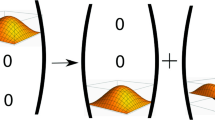Abstract
The interaction potentials of electrons with the basal and prismatic planes, as well as with the c and \(\left\langle {2\bar {1}\bar {1}0} \right\rangle \) axes in hexagonal close-packed crystals (in particular, in crystals of Be, Sc, Ti, Co, Zn, Y, Zr, Tc, Ru, Cd, and La) at a temperature of 300 K are calculated in the Molière approximation. For comparison, the potentials of electron interaction with the {100} planes and the 〈100〉 axes in cubic crystals of Li, Ca, V, Fe, Cu, Sr, Nb, Mo, Rh, Ag, and Ba with body-centered or face-centered lattices are calculated. The choice of these crystals is due to the fact that the atoms from which they are built are adjacent in the Periodic Table. Calculations show that potential wells, as a rule, are deeper in hexagonal crystals than in cubic ones, both in the planar and axial cases. For relativistic electrons with the Lorentz factor γ = 20, when solving the corresponding Sturm–Liouville problems, the energy levels of transverse motion and the corresponding wave functions are found numerically. The spectra of the spontaneously channeling radiation are also numerically calculated in the dipole approximation for a dispersion-free electron beam moving at zero angle with respect to the corresponding crystallographic plane and axes. It is shown that the frequencies and amplitudes of the spectral peaks, as well as the total intensities of these spectra in crystals with a hexagonal structure, are more efficient for practical use than similar characteristics in cubic crystals.







Similar content being viewed by others
REFERENCES
R. L. Swent, R. H. Pantell, H. Park, et al., Phys. Rev. B 29, 52 (1984).
B. L. Berman, J. O. Kephart, S. Datz, et al., Nucl. Instrum. Methods Phys. Res., Sect. B 119, 71 (1996).
K. B. Korotchenko, Yu. L. Pivovarov, and N. A. Tukhfatullin, Nucl. Instrum. Methods Phys. Res., Sect. B 266, 3753 (2008). https://doi.org/10.1016/j.nimb.2008.03.203
A. S. Gevorkyan, K. B. Oganesyan, E. A. Ayryan, and Yu. V. Rostovtsev, arXiv:1701.07637 (2017).
E. A. Ayryan, A. S. Gevorkyan, M. Hnatic, et al., arXiv:1705.0993 (2020).
N. V. Maksyuta, V. I. Vysotskii, and S. V. Efimenko, J. Phys.: Conf. Ser. 732, 012023 (2016). https://doi.org/10.1088/1742-6596/732/1/012023
N. V. Maksyuta, V. I. Vysotskii, S. V. Efimenko, and Yu. A. Slinchenko, J. Surf. Invest.: X-ray, Synchrotron Neutron Tech. 13, 1296 (2019). https://doi.org/10.1134/S1027451019060417
N. V. Maksyuta, V. I. Vysotskii, and S. V. Efimenko, Nucl. Instrum. Methods Phys. Res., Sect. B 355, 90 (2015). https://doi.org/10.1016/j.nimb.2015.02.010
N. V. Maksyuta, V. I. Vysotskii, S. V. Efimenko, and Yu. A. Slinchenko, J. Instrum. 13, C04010 (2018). https://doi.org/10.1088/1748-0221/13/04/C04010
N. V. Maksyuta, V. I. Vysotskii, S. V. Efimenko, and Yu. A. Slinchenko, J. Surf. Invest.: X-ray, Synchrotron Neutron Tech. 15, 1109 (2021). https://doi.org/10.1134/S1027451021050347
N. V. Maksyuta, V. I. Vysotskii, S. V. Efimenko, and Yu. A. Slinchenko, Vopr. At. Nauki Tekh., No. 3, 133 (2021). https://doi.org/10.46813/2021-133-019
N. V. Maksyuta, V. I. Vysotskii, and S. V. Efimenko, in Proc. 50th Int. Tulinov Conference on Physics of Interaction of Charged Particles with Crystals (Univ. Kniga, Moscow, 2021), p. 62.
N. W. Aschcroft and N. D. Mermin, Solid State Physics (Holt, Rinehart and Winston, New York, 1976; Vol. 1, Mir, Moscow, 1979).
T. A. Bobrova and L. I. Ognev, Preprint no. IAE-4810/11 (Inst. At. Energy, Moscow, 1989).
W. Wagner, B. Azadegar, L. Sh. Grigoryan, and J. Pawelke, Europhys. Lett. 78, 56004 (2007). https://doi.org/10.1209/0295-5075/78/56004
V. R. Biraz, V. P. Levchenko, and A. A. Povzner, Structure and Physical Properties of Crystals (Ural. Gos. Univ., Yekaterinburg, 2009) [in Russian].
V. A. Bazylev and N. K. Zhevago, Radiation of Fast Particles in Matter and in External Fields (Nauka, Moscow, 1987) [in Russian].
N. P. Kalashnikov, Coherent Interaction of Charged Particles in Single Crystals (Atomizdat, Moscow, 1981) [in Russian].
Y.-H. Ohtsuki, Charged Beam Interaction with Solids (Taylor and Francis, London, 1983; Mir, Moscow, 1985).
J. U. Andersen, E. Bonderup, E. Laegsgaard, et al., Nucl. Instrum. Methods Phys. Res., Sect. B 194, 209 (1982).
Author information
Authors and Affiliations
Corresponding author
Ethics declarations
The authors declare that they have no conflicts of interest.
Additional information
Translated by Yu. Ryzhkov
Rights and permissions
About this article
Cite this article
Maksyuta, N.V., Vysotskii, V.I. & Efimenko, S.V. Spontaneous Emission during the Channeling of Relativistic Electrons in Crystals with a Hexagonal Structure. J. Surf. Investig. 16, 312–319 (2022). https://doi.org/10.1134/S1027451022030272
Received:
Revised:
Accepted:
Published:
Issue Date:
DOI: https://doi.org/10.1134/S1027451022030272




